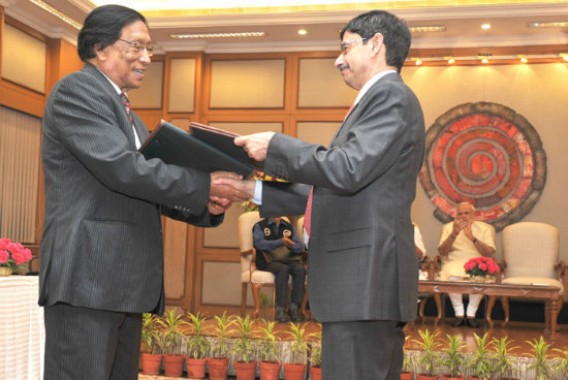Journalists or drum-beaters?
On 3 August, Prime Minister Narendra Modi announced the signing of a political accord with the National Socialist Council of Nagaland ( Issac-Muivah faction). Thuingaleng Muivah , general secretary of the NSCN faction, signed it on behalf of his group and government interlocutor for the Naga peace dialogue R N Ravi signed it on behalf of the government. The Press Information Bureau issued press note and videos were also given out with bytes from Modi, Muivah and others involved with the accord. Modi described the accord as 'historic', blamed the long delay on Nagas and Indians not understanding each other for a long time and and said the accord was 'historic' because it will help end sixty years of conflict involving the Nagas and Indian security forces.
But neither Modi nor Muivah spelt out what the accord contained and what it was all about. The text of the accord was kept a closely guarded secret. Unlike the accords signed in Northeast by late prime minister Rajiv Gandhi, when the text of the accords were made available to the media immediately after they were signed, the Modi government has still kept the Naga accord under the wraps. Selective leaks here and there have fuelled speculation.
But the media , from TV to print, lapped up what Modi said -- that the accord was 'historic'. Delhi-based Northeast experts joined the full throated trumpeting on national TV channels, supporting Modi's contention that the accord was historic.
Only a few like me and my Naga journalist friend Bano Haralu (former northeast bureau chief of NDTV), who have spent a lifetime trying to understand the Northeast and lived in the region, introduced an element of circumspection. We have no reason to believe it was a 'historic agreement' simply it was signed with one Naga rebel faction, not with the entire movement as was the case in Mizoram. It is also not historic because Nagaland chief minister T R Zeliang has now gone on record to say it is 'only a formula for a final accord'.
Exactly like what the 1975 Shillong Accord signed by the Indira Gandhi government with the Naga National Council (NNC) was -- a settlement to pave the way for a final settlement was how the preamble to the Shillong accord was phrased.
The only historic element about the Modi-Muivah accord , as some would now like to describe the settlement, was the length of negotiations involved -- 18 years to be precise.
Some misguided critics of the Modi government are describing this as a 'draft accord' which it is not -- this is not a draft but something that has been signed by competent authorities. The Modi-Muivah accord is actually a 'framework agreement '' -- to provide a framework within which a final settlement will be worked out.
Which means the final settlement to end Naga insurgency is some time away . It has not happened yet.
But look at the media ! Exactly like in the case of the trans-border action against NSCN's Khaplang faction which was wildly exaggerated by national media, TV and print alike, they have again got a major Northeast story absolutely wrong because they just jumped and lapped up what the Prime Minister and all his men said.
Then it was the tall claims of Indian para-commandos going inside Myanmar and killing anything between 50 to 150 rebels -- now it is about a 'historic accord' whose provisions are still not known. On both occassions, the wild trumpeting has made many feel that the entire Indian media is an 'embedded' one; when it comes to Northeast.
Calling this Naga accord a 'historic' one is a 'historic blunder' , to use the late Jyoti Basu's words .
The only way to redeem its lost credibility is to now go after all the Modi's men and ferret out the details of the Naga accord and then hold realistic panel discussions or run spotlight pages on whether it is historic or not.
I only hope they don’t miss interesting snippets , rather pointers, like the proposed visit of Naga politicians to meet NSCN's breakaway Naga leader S SKhaplang in his lair in Myanmar's Sagaing .
This is an official trip perhaps to get Khaplang to accept the Accord and its final provisions.
Clearly Myanmar is helping India solve its Naga problem even after been upset with the loose talk by the likes of Rajyavardhan Rathore over the June trans-border raid.
